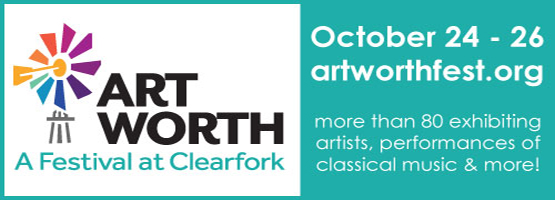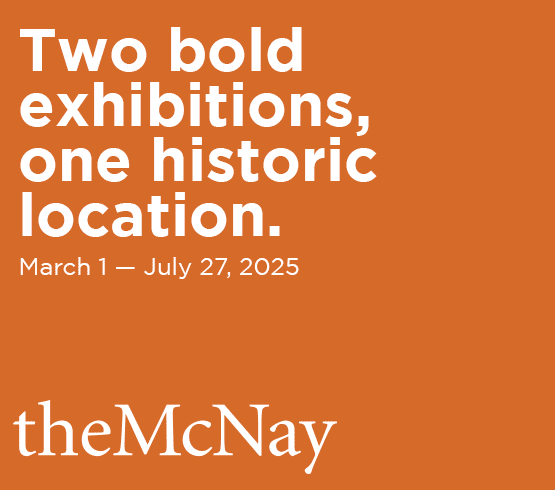Rebecca Manson transforms clay into charged flora in her immersive installation, Barbecue, at the Modern Art Museum of Fort Worth from May 24 through Aug. 25. Composed of more than 45,000 handmade and colorfully glazed ceramic leaves installed in the ellipse, the Modern’s oval first-floor gallery, the exhibition invites viewers to walk along a designated trail winding through the space. The transformation of the concrete-walled space into an autumnal environment invites visitors to contemplate universal questions regarding mortality, nostalgia, memory, and humanity’s connection to nature.
The glazed leaves are presented in a palette of jade-like greenish blues, rich merlot reds, browns, yellows, and oranges. According to Milliken, Manson spends a considerable amount of time enveloped in the natural world, walking daily to observe specific locations as the seasons change, especially in autumn. Her leaves echo the cyclical nature of life, progressing from one stage to another, as well as the emotions triggered by the passage of time and mortality.
The title of the show, Barbecue, is inspired by a ceramic barbecue grill situated among the mounds of leaves, along with ceramic flowers, strips of bark, newspaper, matches, and other detritus. In collaboration with glass artist Jessica Tsai, Manson also has included glass onions, uncooked and cooked chicken, charcoal, and embers.
The artist was just 8 when she discovered ceramics. In an interview for Artspace (Oct. 4, 2023), she said that ceramics saved her. “I was a pretty reclusive kid and didn’t really have many friends. I spent every Saturday and Sunday—eight hours each of those days—at this pottery school in a very obsessive way. In the summers, I would go to camps where I would just do that. I got really pretty advanced at making pottery from a traditional standpoint. So, by the time I entered my teens, it was just sort of a natural course.”
Manson remembers collecting leaves with her father in her youth and pressing them into notebooks. She rediscovered these books in recent years and was inspired to experiment with reproducing dried leaves in clay. That path eventually led to major installations involving leaf forms like Barbecue and Gutter, a large ceramic installation inspired by those the artist encountered when cleaning out her gutters. Milliken saw this piece at Miami Basel in December 2021 and met Manson. They have been working on the Modern show for nearly two years.

1 ⁄6
Rebecca Manson
Barbecue, 2024
Porcelain, glaze, steel, adhesives and glass
Dimensions variable
© Rebecca Manson. Courtesy of the Artist.
Photographs by Evie Marie Bishop

2 ⁄6
Rebecca Manson
Barbecue, 2024
Porcelain, glaze, steel, adhesives and glass
Dimensions variable
© Rebecca Manson. Courtesy of the Artist.
Photographs by Evie Marie Bishop

3⁄ 6
Rebecca Manson
Barbecue, 2024
Porcelain, glaze, steel, adhesives and glass
Dimensions variable
© Rebecca Manson. Courtesy of the Artist.
Photographs by Evie Marie Bishop

4 ⁄6
Rebecca Manson
Barbecue, 2024
Porcelain, glaze, steel, adhesives and glass
Dimensions variable
© Rebecca Manson. Courtesy of the Artist.
Photographs by Evie Marie Bishop

5 ⁄6
Rebecca Manson
Barbecue, 2024
Porcelain, glaze, steel, adhesives and glass
Dimensions variable
© Rebecca Manson. Courtesy of the Artist.
Photographs by Evie Marie Bishop

6 ⁄6
Rebecca Manson
Barbecue, 2024
Porcelain, glaze, steel, adhesives and glass
Dimensions variable
© Rebecca Manson. Courtesy of the Artist.
Photographs by Evie Marie Bishop
There are various ways for the viewer to engage with Barbecue. The trail through the piles allows for both macro- and micro-viewing of the work and offers opportunities for contemplation at every stage of the installation. Using the same path, the viewer returns to their starting point, engaging with the work from a different perspective on the return journey.
“Seeing Rebecca handle her material has changed the way I view ceramics,” said Milliken. “Her leaves and flowers are not as fragile as they appear. Everything is rooted in reality, but it’s still very fantastical.”
Manson’s work is both spectacular and menacing, as it surrounds and engulfs the viewer. One is forced to consider nature and humanity’s relationship to it, as industrialization and pollution threaten to destroy the natural environment. In an interview with the curator, Manson said, “I create an overwhelming environment to evoke our smallness in the face of nature and dependency upon it. This hyperbolic fantasy is a call for empathy and prompts us to challenge the unnatural changes we impose upon our climate.”
—DONNA TENNANT




